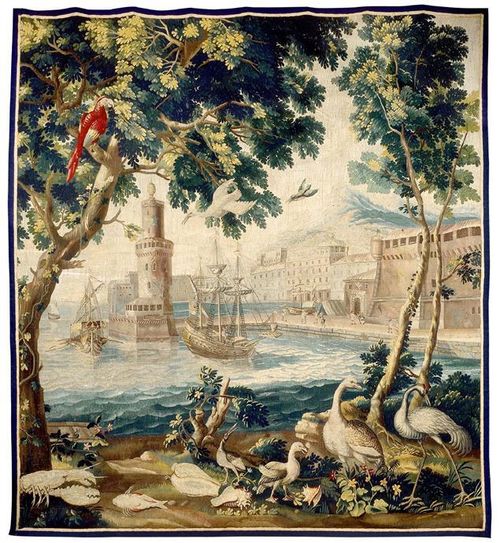Resource LibraryHistory of tapestries Tapestries have been woven for hundreds of years in diverse cultures. Both ancient Egyptians and the Incas buried their dead in tapestry woven clothing. Important civic buildings of the Greek Empire, including the Parthenon, had walls covered by them. However it was the French medieval weavers who brought the craft to fruition. In the 13th and 14th centuries the Church recognized the value of tapestries in illustrating Bible stories to its illiterate congregations. The oldest existing set is the Apocalypse of St John which were woven from 1375 to 1379 in Paris. This was the centre of production until the Hundred Years War (1337 - 1453) caused the weavers to flee north via Arras to Flanders (now Belgium and northern France). By 1500, Flanders, especially Brussels and Bruges, had become the chief places of production. Due to their size and intricacy, tapestries became investments and displays of wealth and power. "Les vaisseaux" fine silk and wool Beauvais Tapestry Medieval weavers used working sketches which they freely adapted with imagination and sometimes humour. By the Renaissance these had become full-sized working drawings ('cartoons') which were rigidly copied by the weavers. In 1663, during the lavish reign of Louis XIV, Les Gobelins factory was founded in Paris employing over 800 artisans in the production of tapestries for the royal court. Other European countries followed, opening factories on behalf of their rulers. They employed Flemish weavers who by now had to complete a twelve year apprenticeship. Louis XIV's estate inventory at his death listed 2,155 Gobelins tapestries. The Beauvais tapestry manufacture was the second in importance, after the Gobelins tapestry, of French tapestry workshops that were established under the general direction of Jean-Baptiste Colbert, the finance minister of Louis XIV. Whereas the royal Gobelins manufacture executed tapestries for the royal residences and for ambassadorial gifts, the manufacture at Beauvais always remained a private enterprise. Rococco landscapes were popular in the 18th century typified by the designs of Francois Boucher (1703-70), director of the royal workshops at Beauvais for 30 years. His cartoons produced over 400 tapestries. During the French Revolution the social changes of the times so decimated the tapestry market that the French Directory ordered 190 be burnt in 1797 rather than retain them for their value complete. They considered the gold and silver threads to have greater value. A positive development of this period however was the invention of the Jacquard mechanical loom in Flanders in 1804. It processed perforated cards, like pianolas which fed the coloured yarns to the shuttle. |


